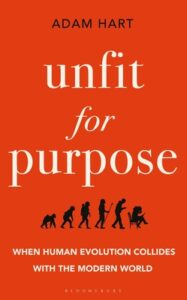 Unfit for Purpose, Adam Hart
Unfit for Purpose, Adam Hart
Unfit for Purpose expands on a familiar-sounding theme: humans evolved over millions of years for a certain set of circumstances, but in recent centuries we’ve changed how we live entirely so that the bodies that we’ve developed and the genes we carry are optimised for a hopelessly different world… and sometimes they prove to be a disadvantage. The obvious first target is body fat storage, and Adam Hart goes straight there like a bird to the nest.
I’m not an expert on the subject, but I know I’ve read better coverage of the “obesity crisis” than Adam Hart manages here. Obesity is just bad, per Hart, and though he doesn’t embrace the idea of BMI uncritically, I know I’ve read counter-arguments for several of his points. As a scientist, I probably should spend some time tracking down this info… as a person, however, this doesn’t interest me, so it’s just worth being aware of if you pick the book up. There is not even a mention of “health at every size” thinking here.
I found the other topics similarly skimmed across. It’s amazing that he managed to mention Stanley Milgram’s experiments as a key part of how our psychology makes us ill-adapted to modern life… and used only a page to discuss them, even though it’s actually a complex issue, with many critiques of Milgram’s experiments (not least the accusation, per Gina Perry’s book, that he cherry-picked his data and massaged the scenarios to get the answer he wanted).
In the end, Hart’s main point isn’t wrong. We didn’t evolve for a situation like this… but I think part of the problem is imagining that any organism ever did. Evolution broadly shapes a species, of course, but what each species is adapted to is not the current circumstances, but those of their forebears. Humans have created change on a massive scale, shaping our environments, rapidly changing the way we live and altering our interactions with other species.
Of course we’re not adapted for this. No species ever is, and we’ve sped things up so much that it becomes incredibly obvious. I found Hart’s analysis fairly obvious and high-level — which one would expect from a popular science book, of course, but even if the pop-science book doesn’t dig deep, the author should have. There were some interesting bits, but knowing there was more digging to be done on some of these topics to get a fair impression of the landscape leaves me very hesitant to uncritically believe the pictures Hart paints.

Leave a Reply